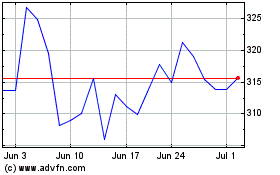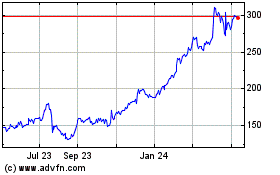By Anne Steele
This article is being republished as part of our daily
reproduction of WSJ.com articles that also appeared in the U.S.
print edition of The Wall Street Journal (April 30, 2020).
Spotify Technology SA continued to add paying and
advertising-supported users in the most recent quarter, but it
lowered its revenue guidance for the year as ad sales were dented
amid uncertainty around the coronavirus pandemic.
The global health crisis began to affect the business in late
February, the company said, with a notable decline in daily active
users and consumption in hard-hit markets such as Italy and Spain.
Listening has started to rebound in recent weeks, with consumption
in many markets "meaningfully recovered."
The decline in consumption didn't drag on user growth: For the
quarter that ended March 31, Spotify had 286 million monthly active
users, at the high end of the company's expectations. It had 130
million paying subscribers, its most lucrative type of customer,
also at the high end of its guidance.
Shares in the Stockholm-based company closed roughly 11% higher
at $156 Wednesday in New York.
Monthly churn, or the number of users who end a subscription,
improved compared with the year earlier, the company said, despite
some impact from the effect of Covid-19 -- a modest increase in
cancellations and payment failures. Spotify said one in six
respondents to its exit survey in the U.S. cited Covid-related
reasons for canceling their accounts, with more than 80% indicating
they are extremely likely or likely to renew once the economic
situation improves.
In a letter to investors, the company noted that use of its
service in cars, on wearable devices and on the web declined, while
its audience through television and videogame consoles grew by more
than 50%. Spotify said its data indicate morning routines have
changed, and every day looks more like the weekend, with fewer
people commuting to work. Still, listening time around activities
like cooking, family time and relaxing has increased, as has
consumption of podcasts related to wellness and meditation.
"We've seen some massive shifts in user behavior," said Chief
Executive Daniel Ek in an interview. "People are listening more to
classical and chill music."
Mr. Ek has said Spotify's focus is less on its streaming
competitors and more on the billions of listeners of terrestrial
radio.
"The trend we've been seeing is everything linear moves to
on-demand," he said Wednesday. "This pandemic will accelerate that
trend."
With fewer people tuning in to radio in their cars, Spotify has
seen more pronounced user growth.
"Because we offer a personalized and on-demand experience, they
end up staying," he said.
On a call with investors, Mr. Ek said Spotify's free tier is
more valuable now than ever, noting that 60% of paid subscribers
come in through the ad-supported service. He also said the service
has seen many listeners with lapsed accounts come back in recent
weeks.
During the quarter, average revenue per user for the
subscription business declined 6% to EUR4.42 ($4.78), partly due to
an extended free-trial period from the previous quarter, but also
owing to new subscribers coming in via discounted plans through
family and student accounts, and lower pricing power in
international markets.
Spotify's revenue from subscriptions rose a better-than-expected
23% to EUR1.7 billion. Ad-supported revenue -- which had been on a
double-digit rise in recent quarters -- dropped 32% to EUR148
million, falling short of expectations. The company said before the
pandemic that revenue was pacing ahead of its forecast, but sales
decelerated in March as previously booked business was canceled or
paused, and programmatic buyers pulled back spending.
Though advertising is a relatively small part of Spotify's
business -- accounting for 10% or less of overall revenue -- it has
been a growth area over the past year as the company expands its
podcast business.
While the hit to Spotify's podcast listening was bigger than
music at the beginning of stay-at-home orders, it has also
rebounded, with news and science podcasts performing particularly
well, and some shows like "Science Vs" adding episodes.
Executives said they plan to continue to invest in podcasts --
of which it now has more than three million on its platform -- as a
long-term bet, and anticipate a depressed ad market could make
exclusive and original deals with Spotify a more attractive
opportunity for many podcasters.
Meanwhile, Spotify said it expects its "two-sided marketplace,"
where it sells tools and services to artists and their
representatives, to grow 50% this year. Late last year, the company
introduced sponsored recommendations, which lets labels pay to
promote new music to specific listeners. The company said
click-through and conversion rates are strong, and that Vivendi
SA's Republic records booked a campaign to promote the Weeknd's new
album.
In all for the period, Spotify swung to a profit of EUR1 million
from a loss of EUR142 million. Owing to accounting issues, the
company reported a per-share loss of 20 European cents, compared
with a loss of 79 European cents in the same quarter a year
earlier. Revenue jumped 22% to EUR1.85 billion, in line with
guidance.
For the current quarter, the company guided for monthly active
users to grow to between 289 million and 299 million. Paying
subscribers are projected to rise to between 133 million and 138
million, and revenue is projected between EUR1.75 billion and
EUR1.95 billion.
The company backed its monthly-active-user and subscriber
guidance for the year but trimmed both ends of its revenue guidance
to EUR7.65 billion to EUR8.05 billion from EUR8.08 billion to
EUR8.48 billion, citing changes in foreign exchange rates and the
impact of Covid-19 on advertising expectations.
News Corp's Dow Jones & Co., publisher of The Wall Street
Journal, has a content partnership with Spotify's Gimlet Media
unit.
Write to Anne Steele at Anne.Steele@wsj.com
(END) Dow Jones Newswires
April 30, 2020 02:47 ET (06:47 GMT)
Copyright (c) 2020 Dow Jones & Company, Inc.
Spotify Technology (NYSE:SPOT)
Historical Stock Chart
From Mar 2024 to Apr 2024

Spotify Technology (NYSE:SPOT)
Historical Stock Chart
From Apr 2023 to Apr 2024
